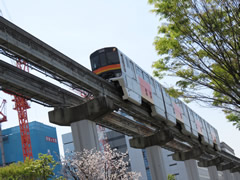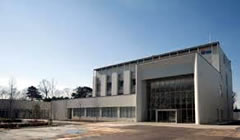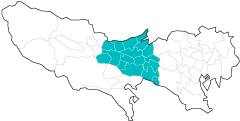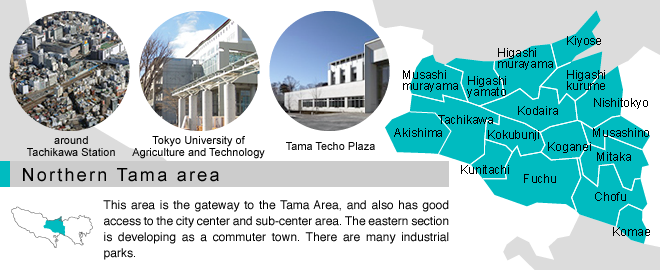 Northern Tama area
Northern Tama area
 Area Features
Area Features
 Tama Monorail in Tachikawa City
Tama Monorail in Tachikawa City
This is the gateway to the Tama Area. The eastern section is developing as a commuter town.
Through a well-developed JR and private railway network, this area also has good access to the city center and sub-center area. The Tama Monorail is also used for commuting to work and school within the area.
Access to the Kanto region is also convenient using the Chuo Expressway.
 Manufacturing Industry Features
Manufacturing Industry Features
 Information Technology Image
Information Technology Image
The Northern Tama area has the second largest number of manufacturing industry employees in the Tokyo metropolis, with over 51,000, and the shipment value of manufactured goods is No.1 in Tokyo, accounting for about 27.9% of the total shipment value in Tokyo.
Among these products, information and communication devices produced in Fuchu City and Akishima City make up about 70 percent of all such production in Tokyo.
Akishima City have industrial parks.
 Support Facilities and Property Situation
Support Facilities and Property Situation
 Tama Techo Plaza
Tama Techo Plaza
The Tama Techno Plaza is a support base for many small and medium-sized enterprises (SMEs) centering on those in the Tama Area. It provides support from various angles in response to the needs of companies such as implementing entrusted tests, use of equipment, joint research, various consultations, coordination of industry-academia-government collaboration, and group activities for exchange between different industries.
 Basic Data
Basic Data

| Municipalities |
|---|
| Mitaka, Chofu, Koganei, Fuchu, Musashino, Komae, Higashimurayama, Kodaira, Kokubunji, Kunitachi, Higashiyamato, Kiyose, Higashikurume, Musashimurayama, Nishitokyo, Tachikawa, Akishima |
| Population |
Number of establishments in manufacturing business |
Number of employees in manufacturing business |
Shipment value
(unit: ten million yen)
|
Added value
(unit: ten million yen)
|
|
|---|---|---|---|---|---|
| Mitaka | 186,375 | 148 | 1,704 | 3,365 | 1,479 |
| Chofu | 232,473 | 175 | 2,402 | 5,265 | 2,413 |
| Koganei | 120,268 | 46 | 395 | 654 | 359 |
| Fuchu | 258,654 | 235 | 13,797 | 77,100 | 12,141 |
| Musashino | 144,902 | 64 | 487 | 887 | 377 |
| Komae | 81,788 | 65 | 507 | 1,645 | 457 |
| Higashimurayama | 151,018 | 160 | 2,975 | 6,192 | 2,490 |
| Kodaira | 191,308 | 138 | 6,039 | 11,909 | 3,480 |
| Kokubunji | 121,673 | 55 | 1,140 | 1,858 | 880 |
| Kunitachi | 75,723 | 39 | 333 | 450 | 268 |
| Higashiyamato | 85,718 | 91 | 1,298 | 8,972 | 3,136 |
| Kiyose | 74,845 | 42 | 963 | 1,929 | 625 |
| Higashikurume | 116,830 | 98 | 3,396 | 16,292 | 6,376 |
| Musashimurayama | 72,489 | 224 | 4,399 | 10,341 | 4,745 |
| Nishitokyo | 201,058 | 95 | 1,015 | 9,243 | 1,611 |
| Tachikawa | 182,658 | 150 | 3,609 | 10,687 | 4,465 |
| Akishima | 113,244 | 189 | 8,593 | 60,072 | 19,855 |
| total of this area | 2,411,024 | 2,014 | 53,052 | 226,861 | 65,157 |
| total of Tokyo | 13,637,346 | 27,142 | 296,132 | 854,522 | 338,191 |
Source:
・Ministry of Internal Affairs and Communications, "Basic resident register", 2018/1/1
・Industry and Employment in TOKYO 2018, Bureau of Industrial and Labor Affairs, Tokyo Metropolitan Government


